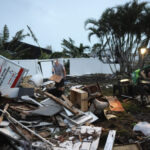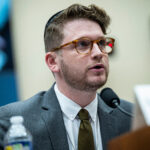Judge Warren Ettinger, Los Angeles Superior Court, ruled this week that Dr. Juan Manuel Gutierrez, Ph.D., Board Certified neuropsychologist may offer his expert opinion that exposure to toxic mold was the cause of a Plaintiff’s permanent brain injury.
In the case of Dee v PCS (case # No.LC057263), Plaintiff Darcee Dee, a former resident of Mammoth Park Towers in Sherman Oaks, California — billed as “Luxury Apartment Homes, Completely Renovated” — has filed for damages in a suit in Los Angeles Superior Court.
The defendants PCS Property Management LLP and 8611 Venice Blvd. Corp are either owned directly or indirectly by another LLP, whose principle is local PCS Telecommunication’s magnate, Joe Fryzer. The defendants own and manage 40 other high end luxury apartment buildings in Beverly Hills and Los Angeles, promoted with the motto: “We don’t just say it, we mean it. Better Living. Better Life”.
Attorney for Dee, Scott Whitenack, Esq. (AKA Scott B. Stubblefield) from Westlake Village, California, is a published trial lawyer on the issue of Broker Fraud. He stated that his client said she never got to enjoy the “better living, better life” as represented by PCS. Instead, what she got was permanent brain injuries from her exposure to toxic mold while residing at the “Luxury Mammoth Pak Towers.”
PCS Corp. has reportedly admitted that toxic mold was found in Dee’s apartment. PCS employee, Karen Mackie-Thaler, then reportedly ordered the maintenance supervisor to open the walls for “Destructive Testing” while Dee was still living in the apartment. The notorious Stachybotrys specie and other toxic molds harmful to Dee’s health were reportedly found to be rampant.
PCS and Mackie-Thaler reportedly represented to Dee that the May 14, 2001 mold tests were inconclusive and further testing was needed. According to Dee’s attorney, in reality, PCS and Mackie-Thaler intentionally concealed from Dee the findings of Stachybotrys and other toxic molds at the subject property and never bothered to establish whether the destructive testing would be harmful to Dee’s health. There is also reported to be proof that PCS and Mackie-Thaler concealed from Dee further destructive testing was scheduled for June 1, 2001.
Whitenack said the evidence proves that PCS failed to move Dee from the apartment even after PCS was reportedly told to do so by their own vice president. It also reportedly proves that the ultimate decision to leave Dee unaware and in a dangerously contaminated environment was made by Paul Jennings. Jennings is the co-owner and COO of PCS and affiliated entities.
Whitenack went on to state that Dee was seeking punitive damages to punish the defendants for willful misconduct, in addition to her claim for personal injury. The total amount of the claim is more than $6,000,000.
In a precedent-setting decision, Whitenack stated that an important victory was won (for all U.S. citizens) by the Court’s ruling that Dr. Gutierrez, Ph.D. was qualified as an expert to testify that the cause of Dee’s brain injury stemmed from her exposure to toxic mold.
“During preliminary motions by insurance defense firms, they seek to deny the opinions of Plaintiffs’ expert witnesses, thus preventing any testimony by the experts as to causation. The purpose of this maneuver is to defeat claims and reduce the amount of monies insurance companies have to pay, ” said Whitenack.” In my experience with mold cases, I have found that the defense expert’s witnesses base their opinions on medical studies or position papers prepared or sponsored by quasi insurance defense funded organizations, that have intentionally failed to include a cross-section of the hundreds — if not thousands — of medical studies that support the complete opposite conclusions.”
Prior to this case, showing a direct causal connection between the exposure to toxic mold and the resultant injuries of victims has been a sticking point in numerous past cases.
For those affected, the tangled web of claims procedures can be a nightmare in itself. Plaintiffs are required to submit to the “independent medical exam (IME)” performed by the physician of the defendant’s choice. This is reportedly true in both personal injury and workman compensation claim proceedings. Plaintiffs are then reportedly faced with the one sided, predetermined opinion: that their injuries were not caused by exposure to the mold. Independent analysts have noted that the position of the defense hinge almost exclusively on the findings of two studies: The Institute Of Medicine’s, “Damp Indoor Spaces and Health” dated May 25, 2004 (IOM report) or the American College of Occupational and Environmental Medicine Position Paper released in 2002, (ACOEM report) or both.
The IOM report recently came under fire in an earlier release of Jan. 27, 2005, entitled “Surgeon General’s Office Issues Conflicting Message on “Toxic Mold”. The (IOM Report) “failed to convey that the study was only charged to investigate allergic and non-infectious respiratory symptoms of fungal exposure, and that their findings never included examination of other serious symptoms.” The (IOM) study was sponsored at the request of the CDC after much public debate on the issue. The study was reportedly widely quoted in the popular press and has since been used in defense litigation in a case in Arizona where a woman was reported to have experienced severe injuries from mold exposure in a Phoenix apartment.
Whitenack further said that Dr. Gary Ordog, M.D. was to testify on Feb. 22, in Department “19” of the downtown Los Angeles Superior Court.
The court was to determine at the request of the defense, if Dr. Ordog will qualify as an expert toxicologist and if he will be permitted to testify at time of trial. Dr. Ordog is the medical director of the only independent Medical Toxicology program in California. His office of Medical Toxicology reportedly currently sees more patients than any other in the country with the diagnosis of toxicity. He is currently the only facility in the county — other than the military — that offers a full diagnostic and treatment facility for those suffering from mold exposure. Dr. Ordog has reportedly recently come under much attack from the insurance defense industry, as he is one of several in the country that have been permitted to testify at hearings or in trials as to toxic mold claims.
Whitenack finally stated that the insurance defense firms in this case would follow their same plan and scheme, and were to call their retained expert, Dr. Marion Fedoruk, M.D. on Feb. 24. Dr. Fedoruk was expected to testify consistent with his declaration — that Plaintiff’s injuries were not caused by the exposure of toxic mold — again basing his opinions on the 2 controversial reports: (IOM report) and (ACOEM report).
The 20-30 day jury trial is set to start on Feb. 28, with the selection of jurors.
Was this article valuable?
Here are more articles you may enjoy.

 UBS Client Can’t Sue Bank Over Broker’s Alleged Affair With Wife
UBS Client Can’t Sue Bank Over Broker’s Alleged Affair With Wife  Here Comes Another Busy Atlantic Hurricane Season, But Will It Be as Crazy as 2024?
Here Comes Another Busy Atlantic Hurricane Season, But Will It Be as Crazy as 2024?  Harvard Settles Lawsuit by Former Student Claiming Antisemitism
Harvard Settles Lawsuit by Former Student Claiming Antisemitism  DIY Home Inspections? They Are Taking Over, Firms Say
DIY Home Inspections? They Are Taking Over, Firms Say 